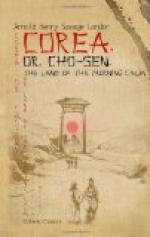With regard to the snake, it is noteworthy that the Coreans have allowed their fancies to run riot in pretty much the same direction as imaginative people in our own country have done, and have not only added wings to their serpents to send them air-faring, but have also invented a near relation to these in the shape of a travelling sea-serpent, which is not, however, of such large dimensions as those with which we are familiar. From this it is only a short step to the well-known half-human, half-fish being and the sea-lion or tiger; stone representations of which are to be seen at the entrance of the Royal Palace. The principal peculiarity of the sea-tiger is its ugliness. It is represented as having a huge mouth, wide open, showing two rows of pointed teeth, and a mane and tail curled up into hundreds of conventional little curlets. If the statues of these sea-tigers are divided in three sections perpendicular to the base, the head will occupy the whole of one of these sections, which, in other words, means that the body is made only twice the size of the head.
The lin is also frequently found figuring in Corean mythology, but this fanciful creature is undoubtedly an importation from the well-known ki-lin of China, being half ox, half deer, and having but a single horn in the centre of the head. It is the symbol of good nature and well-being Another borrowed individual of this class is the dragon, a monster which is a great favourite and much cherished all over the East, though principally by the Emperor of Heaven and his subjects. This popularity of the dragon in the kingdom of the Morning Calm is due, I suppose, in a large measure to the frequent Chinese invasions and constant intercourse of the Chinese with Corea. And yet, upon a less appropriate country, to my belief, he could hardly have been stranded, for, although he possesses all the good virtues of the other mythical creatures of which I have made mention taken together, he certainly is never presented as gifted with that delightful faculty which goes by the name of tranquillity. Restless in the extreme, this genius of the East is said to penetrate through mountains into the ground, skip on the clouds, produce thunder and lightning, and go through fire and water. It can, moreover, make itself visible or invisible at pleasure, and, in fact, can to all intents and purposes do what it pleases, except—remain quiet.
Of dragons there are many kinds, but the most respectable of them all is, as in China, the yellow one, which is as represented on the Chinese flags. Next to the yellow one in popularity comes the green one. In shape, as the natives picture it, the dragon is not unlike a huge lizard, with long-nailed claws, and a flat long head like the elongated head of a neighing horse, possessed, however, of horns, and a long mane of fire, or lightning. The tail is like that of a serpent, with five additional pointed ends. It is, too, rather interesting to note that




